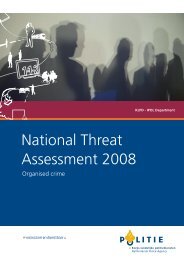Assessing the Effectiveness of Organized Crime Control Strategies ...
Assessing the Effectiveness of Organized Crime Control Strategies ...
Assessing the Effectiveness of Organized Crime Control Strategies ...
You also want an ePaper? Increase the reach of your titles
YUMPU automatically turns print PDFs into web optimized ePapers that Google loves.
<strong>Assessing</strong> <strong>the</strong> <strong>Effectiveness</strong> <strong>of</strong> <strong>Organized</strong> <strong>Crime</strong> <strong>Control</strong> <strong>Strategies</strong>:<br />
A Review <strong>of</strong> <strong>the</strong> Literature<br />
competitors, and encouraging trafficking organizations to become organized crime groups…”<br />
(President’s Commission on <strong>Organized</strong> <strong>Crime</strong>, 1986:388).<br />
The President’s Commission (1986:421-425) was also skeptical about crop<br />
reduction/substitution and eradication programs. Source countries may have little incentive to<br />
reduce crop production as this may undermine <strong>the</strong> economic and political stability <strong>of</strong> <strong>the</strong>ir<br />
countries. Also, drugs that are illicit in North America may be consumed in those countries<br />
(<strong>of</strong>ten as part <strong>of</strong> local traditions); hence, consumption is viewed as an American problem.<br />
Farmers in <strong>the</strong>se countries may not have alternative crops that can provide <strong>the</strong> income generated<br />
by illicit drug crops. Fur<strong>the</strong>rmore, governments in many producing countries are weak and<br />
unable to control crop production. They may also be hostile to <strong>the</strong> US and hence unmotivated to<br />
curtail production.<br />
Most importantly, perhaps, <strong>the</strong> list <strong>of</strong> source countries is not fixed; <strong>the</strong>refore, crop reductions in<br />
one country are <strong>of</strong>ten compensated for by increases in o<strong>the</strong>r countries. With regard to <strong>the</strong> last<br />
point, <strong>the</strong> successful eradication with herbicides <strong>of</strong> opium poppies grown in some parts <strong>of</strong><br />
Nor<strong>the</strong>rn Mexico during <strong>the</strong> 1970s reduced Mexican heroin production; however, within five<br />
years this reduction was replaced by heroin from Sou<strong>the</strong>ast Asia. The use <strong>of</strong> spraying has also<br />
been objected to on <strong>the</strong> basis that <strong>the</strong> herbicides and pesticides used are highly toxic (Del Omo,<br />
1987).<br />
Crop eradication efforts aimed at <strong>the</strong> coca crop in Bolivia and Peru, and <strong>the</strong> poppy crop along <strong>the</strong><br />
Afghan-Pakistani border, have also met with dismal failure (Shannon, 1988:364-367; Atlas,<br />
1988). Bolivia, for example, received economic aid from Washington and <strong>the</strong> United Nations<br />
Fund for Drug-Abuse <strong>Control</strong> to compensate farmers for <strong>the</strong> transition from coca to legal crops,<br />
in return for its agreement, in 1987, to eradicate all coca grown for export within three years.<br />
Various domestic pressures in Bolivia conspired to undermine this plan and, by <strong>the</strong> end <strong>of</strong> <strong>the</strong><br />
first year, just 500 acres <strong>of</strong> coca had been eradicated by <strong>the</strong> government.<br />
Notwithstanding <strong>the</strong>se concerns, <strong>the</strong> President’s Commission on <strong>Organized</strong> <strong>Crime</strong> (1986:425)<br />
did not rule out source country control programs. The Commission called for such programs to<br />
target countries and crops selectively, arguing that crop reduction could reduce <strong>the</strong> availability <strong>of</strong><br />
illicit drugs on a temporary basis. It argued that <strong>the</strong>se efforts should be pursued in those<br />
countries in which <strong>the</strong> political and economic climate was favourable to <strong>the</strong>ir successful<br />
application.<br />
Overall, <strong>the</strong> Commission (1986:429) concluded that supply reduction has been <strong>of</strong> limited success<br />
and that <strong>the</strong> 75-year history <strong>of</strong> this approach in <strong>the</strong> US has “not reduced <strong>the</strong> social, economic, or<br />
crime problems related to drugs…America’s war on drugs seems nowhere close to success.<br />
Now more than ever, drugs present problems <strong>of</strong> vast proportions.”<br />
As an indication <strong>of</strong> <strong>the</strong> limitations <strong>of</strong> <strong>the</strong> supply reduction strategy, <strong>the</strong> President’s Commission<br />
(1986:429) considered an estimated 10 percent interdiction rate, achieved in 1983, to be a<br />
success. Even if this rate could be increased, Latin America’s coca growing could be raised<br />
accordingly. Despite some high-pr<strong>of</strong>ile drug seizures in South Florida in <strong>the</strong> 1980s, Customs<br />
agents can inspect just a small fraction <strong>of</strong> <strong>the</strong> seven million shipping containers landing each<br />
50 | Research and Statistics Division / Department <strong>of</strong> Justice Canada








